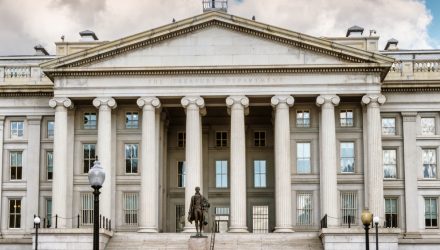With 10-year Treasury yields dangerously flirting with 5% and as some longer-dated Treasury exchange traded funds tumble to multiyear lows, it’s understandable that fixed income investors are seeking shelter from the ongoing bond market storm. No asset is perfect on that front, but floating rate notes (FRNs) are, at the very least, less sensitive to changes in interest rates.
That’s one reason advisors and investors are displaying enthusiasm for ETFs such as the WisdomTree Floating Rate Treasury Fund (USFR).
As of October 18, USFR, which follows the Bloomberg U.S. Treasury Floating Rate Bond Index, had $18.58 billion in assets under management. Impressively, more than $5.46 billion of that tally has flowed into the fund just this year. That was after the ETF added $10.96 billion in new assets last year. In other words, USFR started 2022 with just over $2 billion in assets under management.
With more than $16 billion in inflows in less than 22 months, it’s fair to say USFR is garnering “sticky” capital from advisors and investors, and the fund does not just benefit from tactical rotations among ETF models.
Floating Rate Notes ETF USFR Case Still Strong
One word – duration – highlights the utility of USFR in the current environment. On Thursday, October 19, 10-year Treasury yields settled at 4.98%. That’s certainly high enough to punish long duration bonds and that scenario is playing out in real time. For its part, USFR’s effective duration is just 0.02 years, according to WisdomTree data.
That could be a sign the ETF’s aforementioned $5.46 billion in year-to-date inflows is more floor than ceiling. Without the benefit of a crystal ball, no market participant knows what’s next for interest rates, but for now, the path of least resistance appears to be higher. A move above 5% by 10-year yields could motivate more fixed income investors to evaluate floating rate notes and funds such as USFR.
“They’re especially handy when interest rates are going up. As these rates increase, the interest on floaters also goes up, potentially giving investors more earnings. On the other hand, regular bonds might lose value as newer bonds with better interest rates come into the picture,” reported Investing.com.
What makes USFR all the more compelling is that the ETF doesn’t force investors to make a duration versus income call. Even with that tiny effective duration of 0.02 years, the WisdomTree ETF sports a 30-day SEC yield of 5.39%, highly enticing when considering the fund’s diminished rate risk.
For more news, information, and analysis, visit the Modern Alpha Channel.








